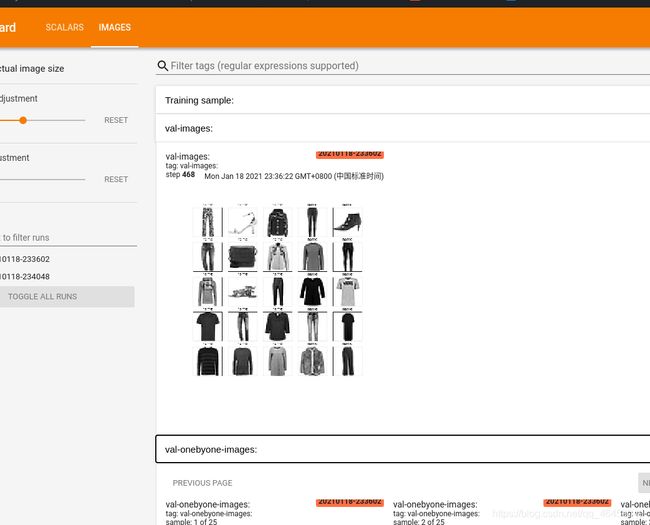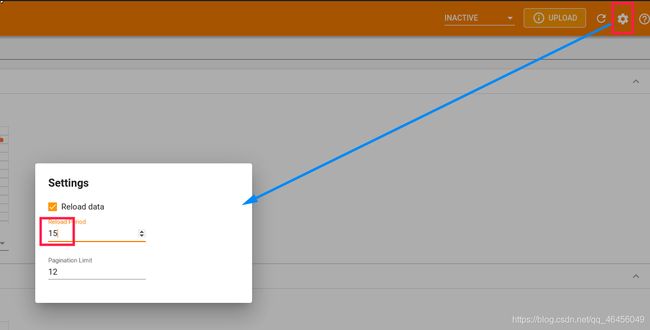Tensorboard可视化
在项目文件夹下创建logs文件夹

tensorboard --logdir logs 命令启动
此命令指定监听的文件夹

进入页面后
这是之前跑的数据


current_time = datetime.datetime.now().strftime("%Y%m%d-%H%M%S")
log_dir = 'logs/' + current_time
summary_writer = tf.summary.create_file_writer(log_dir)
# 上面的代码指定将数据往哪个文件夹下写,并指定本次数据的文件名,此处以时间命名
对图片进行合并操作
def plot_to_image(figure):
"""Converts the matplotlib plot specified by 'figure' to a PNG image and
returns it. The supplied figure is closed and inaccessible after this call."""
# Save the plot to a PNG in memory.
buf = io.BytesIO()
plt.savefig(buf, format='png')
# Closing the figure prevents it from being displayed directly inside
# the notebook.
plt.close(figure)
buf.seek(0)
# Convert PNG buffer to TF image
image = tf.image.decode_png(buf.getvalue(), channels=4)
# Add the batch dimension
image = tf.expand_dims(image, 0)
return image
def image_grid(images):
"""Return a 5x5 grid of the MNIST images as a matplotlib figure."""
# Create a figure to contain the plot.
figure = plt.figure(figsize=(10, 10))
for i in range(images.numpy().shape[0]):
# Start next subplot.
plt.subplot(5, 5, i + 1, title='name')
plt.xticks([])
plt.yticks([])
plt.grid(False)
plt.imshow(images[i], cmap=plt.cm.binary)
return figure
将数据保存到指定文件中
# 取25张图片
val_images = next(db_test_iter)[0][:25]
val_images = tf.reshape(val_images, [-1, 28, 28, 1])
with summary_writer.as_default():
# (图表名称, 数据(y坐标), x坐标)
tf.summary.scalar('test-acc', float(acc), step=epoch)
tf.summary.image("val-onebyone-images:", val_images, max_outputs=25, step=epoch)
val_images = tf.reshape(val_images, [-1, 28, 28])
figure = image_grid(val_images)
tf.summary.image('val-images:', plot_to_image(figure), step=step)
完整代码:
import datetime
import tensorflow as tf
from tensorflow import keras
from matplotlib import pyplot as plt
from tensorflow.keras import datasets, layers, optimizers, Sequential, metrics
import os
import io
os.environ['TF_CPP_MIN_LOG_LEVEL'] = '2'
def preprocess(x, y):
x = tf.cast(x, dtype=tf.float32) / 255.
y = tf.cast(y, dtype=tf.int32)
return x, y
def plot_to_image(figure):
"""Converts the matplotlib plot specified by 'figure' to a PNG image and
returns it. The supplied figure is closed and inaccessible after this call."""
# Save the plot to a PNG in memory.
buf = io.BytesIO()
plt.savefig(buf, format='png')
# Closing the figure prevents it from being displayed directly inside
# the notebook.
plt.close(figure)
buf.seek(0)
# Convert PNG buffer to TF image
image = tf.image.decode_png(buf.getvalue(), channels=4)
# Add the batch dimension
image = tf.expand_dims(image, 0)
return image
def image_grid(images):
"""Return a 5x5 grid of the MNIST images as a matplotlib figure."""
# Create a figure to contain the plot.
figure = plt.figure(figsize=(10, 10))
for i in range(images.numpy().shape[0]):
# Start next subplot.
plt.subplot(5, 5, i + 1, title='name')
plt.xticks([])
plt.yticks([])
plt.grid(False)
plt.imshow(images[i], cmap=plt.cm.binary)
return figure
(x, y), (x_test, y_test) = datasets.fashion_mnist.load_data()
print(x.shape, y.shape)
# plt.figure(figsize=(20, 8), dpi=80)
#
# plt.imshow(x[0])
#
# plt.show()
BATCH_SIZE = 128
# [[x1, y1], [x2, y2]....]
db = tf.data.Dataset.from_tensor_slices((x, y))
db_test = tf.data.Dataset.from_tensor_slices((x_test, y_test))
db = db.map(preprocess).shuffle(10000).batch(BATCH_SIZE)
db_test = db_test.map(preprocess).batch(BATCH_SIZE)
# train时,迭代的是原生db
db_iter = iter(db)
print(next(db_iter)[0].shape)
# Sequential 接收一个列表
model = Sequential([
layers.Dense(256, activation=tf.nn.relu), # [b, 784]@[784, 256] + [256] => [b, 256]
layers.Dense(128, activation=tf.nn.relu), # [b, 256]@[256, 128] + [128] => [b, 128]
layers.Dense(64, activation=tf.nn.relu), # [b, 128]@[128, 64] + [64] => [b, 64]
layers.Dense(32, activation=tf.nn.relu), # [b, 64]@[64, 32] + [32] => [b, 32]
layers.Dense(10) # logits [b, 32]@[32, 10] + [10]=> [b, 10]
])
model.build([None, 28 * 28])
model.summary() # 打印网络信息
optimizers = optimizers.Adam(learning_rate=1e-3)
current_time = datetime.datetime.now().strftime("%Y%m%d-%H%M%S")
log_dir = 'logs/' + current_time
summary_writer = tf.summary.create_file_writer(log_dir)
# get x from (x,y)
sample_img = next(iter(db))[0]
# get first image instance
sample_img = sample_img[0]
sample_img = tf.reshape(sample_img, [1, 28, 28, 1])
with summary_writer.as_default():
tf.summary.image("Training sample:", sample_img, step=0)
db_test_iter = iter(db_test)
# print(next(db_test_iter)[0].shape)
def main():
for epoch in range(1, 20):
for step, (x, y) in enumerate(db):
# [b, 28, 28] => [b, 784]
x = tf.reshape(x, [-1, 28 * 28])
with tf.GradientTape() as tape:
logits = model(x)
y = tf.one_hot(y, depth=10)
prob = tf.nn.softmax(logits)
# MSE => [b] 需要mean成标量才能运算
loss_mse = tf.reduce_mean(tf.losses.MSE(y, prob))
# cross_entryopy注意from_logits设置为True
loss_cros = tf.reduce_mean(tf.losses.categorical_crossentropy(y, logits, from_logits=True))
# 求gradient
grads = tape.gradient(loss_cros, model.trainable_variables)
# 此处需要zip,zip后[(w1_grad, w1),(w2_grad, w2),(w3_grad, w3)..]
optimizers.apply_gradients(zip(grads, model.trainable_variables))
if step % 100 == 0:
print("epoch: %s, step: %s, loss: %s" % (epoch, step, loss_cros.numpy()))
with summary_writer.as_default():
tf.summary.scalar('train-loss', float(loss_cros), step=step)
# test
# test集y不用作one_hot
corr_num = 0
total_num = 0
for (x, y) in db_test:
# x:[b, 28, 28] => [b, 784]
x = tf.reshape(x, [-1, 28*28])
logits = model(x)
prob = tf.nn.softmax(logits)
# prob:int64 [b, 10]
# 注意此处是在第二个维度求最大值
prob = tf.argmax(prob, axis=1)
prob = tf.cast(prob, dtype=tf.int32)
res = tf.cast(tf.equal(y, prob), dtype=tf.int32)
# reduce_sum求出来的时scalar
corr_num += int(tf.reduce_sum(res))
# shape返回的时列表[b, ..]
total_num += x.shape[0]
acc = corr_num / total_num
print("test acc = ", acc)
print(x.shape)
# 取25张图片
val_images = next(db_test_iter)[0][:25]
val_images = tf.reshape(val_images, [-1, 28, 28, 1])
with summary_writer.as_default():
tf.summary.scalar('test-acc', float(acc), step=epoch)
tf.summary.image("val-onebyone-images:", val_images, max_outputs=25, step=epoch)
val_images = tf.reshape(val_images, [-1, 28, 28])
figure = image_grid(val_images)
tf.summary.image('val-images:', plot_to_image(figure), step=step)
if __name__ == '__main__':
main()
